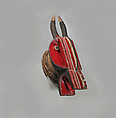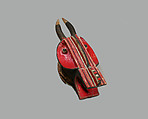Goli Mask (Goli Glin)
Not on view
This carved wood mask does not represent a single, identifiable animal. It is composed of elements from different animals and represents a "bush spirit," emphasizing that it has no counterpart on earth. It is a thing of the "bush" – and things of the bush are male and ungovernable. The mask bears some of the classic details of a bovine head, horns extending from the back and an open jaw with a prominent tongue and teeth. A vine cord is wound around the neck, which is unpainted. The small horns are painted black, with carved striations and white tips. There are two small, protruding eyes and a raised central crest. Stripes of black, white, and red paint animate the face.
This mask constitutes the second in a series of four masks still performed as entertainment by the Baule peoples of central Côte d’Ivoire. The dance series is known as Goli, and this mask as Goli Glin. The mask is worn with an ample costume of woven green palm fronds that emphasizes the association with wild nature. There is no possible way that this costume could be preserved: Baule men always make them just before they are used, and this seems to be part of the meaning of the performance.
During the performance, this mask is one of a pair of identical masks that emerge from the forest together, where bush spirits abide, to enter the village. The long horns, open jaws and teeth are supposed to inspire fear. While women and children are allowed to see these masks they avoid getting too close to them. In contrast, when Kpan, the fourth mask in the series, and the senior female mask, appears in the form of a beautiful female face, women surround it and dance with it.
Due to rights restrictions, this image cannot be enlarged, viewed at full screen, or downloaded.
This artwork is meant to be viewed from right to left. Scroll left to view more.





